|
|
 |
Fiche d'espèce de Copépode |
|
|
Cyclopoida ( Ordre ) |
|
|
|
Sapphirinidae ( Famille ) |
|
|
|
Copilia ( Genre ) |
|
|
| |
Copilia mirabilis Dana, 1849 (F,M) | |
| | | | | | | Syn.: | Copelia mirabilis : Saraswathy, 1966 (1967) (p.104) | | | | Ref.: | | | Brady, 1883 (part., p.117, figs.F); Giesbrecht, 1892 (p.647, 657, 771, figs.F,M); Thompson, 1888 d (p.147); Thompson & Scott, 1903 (p.240, 286); A. Scott, 1909 (p.260, Rem.); Wolfenden, 1911 (p.359); Lehnhofer, 1926 (p.125, 135, 143, figs.F,M); Mori, 1929 (p.204, figs.F,M); Farran, 1929 (p.210, 290); Wilson, 1932 a (p.374, figs.F,M); Rose, 1933 a (p.322, figs.F,M); Dakin & Colefax, 1933 (p.210); Farran, 1936 a (p.132); Mori, 1937 (1964) (p.139, figs.F,M); Dakin & Colefax, 1940 (p.109, figs.F,M); Sewell, 1947 (p.270, Rem.: 2 varieties); Carvalho, 1952 a (p.171, figs.F); Krishnaswamy, 1953 (p.74, Rem.); Chiba & al., 1957 (p.310); 1957 a (p.12); Marques, 1958 a (p.138, figs.F); Fish, 1962 (p.26); Fagetti, 1962 (p.48); Owre & Foyo, 1967 (p.118, figs.F,M); Vinogradov, 1968 (1970) (p.78); Marques, 1968 a (p.397); Stander & De Decker, 1969 (p.29); Paiva, 1971 (p.40, figs.M, Rem.); Ramirez, 1971 (p.91, fig.F, Rem.); Marques, 1973 (p.252); Chen & al., 1974 (p.51, figs.F,M); Marques, 1975 (p.52); Björnberg & al., 1981 (p.672, figs.F,M); Marques, 1982 (p.774); Zheng Zhong & al., 1984 (1989) (p.265, figs.F,M); Baessa de Aguiar, 1986 (1989) (p.64, figs.M); 1988 (1990) (p.185, figs.F, p.75: Rem.); 1991 (p.174); Chae & Nishida, 1994 (p.205, 208, fig.M, color pattern); Chihara & Murano, 1997 (p.992, Pl.231, 232: F,M); Boxshall, 1998 (p.228); Bradford-Grieve & al., 1999 (p.887, 972, figs.F,M); Al-Yamani & Prusova, 2003 (p.126, figs.F); Conway & al., 2003 (p.226, figs.F,M, Rem.); Boxshall & Halsey, 2004 (p.653); Vives & Shmeleva, 2010 (p.359, figs.F,M, Rem.); Al-Yamani & al., 2011 (p.108, figs.F); Gur & al., 21015 (p.8408, cuticular structure vs reflectance, fig.2 e, 3a); Gur & al., 2016 (p.1393, figs. 1, 2, 3, color change vs physical mechanism) |  issued from : F.C. Ramirez in Revta Mus. La Plata, Seccion Zool., 1971, XI. [Lam.III, Fig.1]. Female (from off Mar del Plata): 1, habitus (dorsal). Scale bar in mm: 1.
|
 issued from : Q.-c Chen & S.-z. Zhang & C.-s. Zhu in Studia Marina Sinica, 1974, 9. [Pl.14, Figs.4-8]. As Copilia mirabilis forma typica. Female (from E China Sea): 4, habitus (dorsal); 5, A2; 6, P4. Male: 7, posterior part of the boby (dorsal); 8, A2.
|
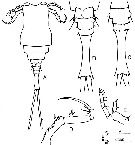 issued from : F.Y. Al-Yamani & I. Prusova in Common Copepods Northwestern Arabian Gulf : Identification Guide. Kuwait Institute for Scientific Research, 2003. [p.127, Fig.48]. Female: A, habitus (dorsal); B, urosome (dorsal); C, idem (ventral); D, A2; E, P4.
|
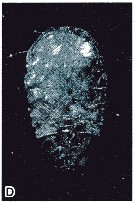 issued from : J. Chae & S. Nishida in Mar. Biol., 1994 (119). [p.208, Thable 2, D). Specific color for the male observed with reflected and transmitted light. Nota: Color observed with reflected (R) and transmitted light (T): Monotonic indigo blue (R); monotonic yellow (T).
|
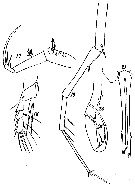 issued from : T. Mori in Zool. Mag. Tokyo, 1929, 41 (486-487). [Pl. IX, Figs.17-21]. Female (from Chosen Strait, Korea-Japan): 17, right A2; 18, P4; 20, left A2. Male: 19, A2; 21, caudal rami.
|
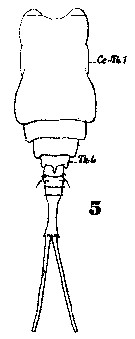 Issued from : W. Giesbrecht in Systematik und Faunistik der Pelagischen Copepoden des Golfes von Neapel und der angrenzenden Meeres-Abschnitte. – Fauna Flora Golf. Neapel, 1892. Atlas von 54 Tafeln. [Taf. 50, Fig.5]. Female: 5, habitus (dorsal).
|
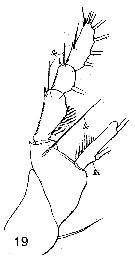 Issued from : W. Giesbrecht in Systematik und Faunistik der Pelagischen Copepoden des Golfes von Neapel und der angrenzenden Meeres-Abschnitte. – Fauna Flora Golf. Neapel, 1892. Atlas von 54 Tafeln. [Taf. 50, Fig.19 ]. Female: 19, P4.
|
 Issued from : W. Giesbrecht in Systematik und Faunistik der Pelagischen Copepoden des Golfes von Neapel und der angrenzenden Meeres-Abschnitte. – Fauna Flora Golf. Neapel, 1892. Atlas von 54 Tafeln. [Taf. 50, Fig.37 ]. Female: 37, A2.
|
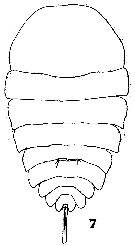 Issued from : W. Giesbrecht in Systematik und Faunistik der Pelagischen Copepoden des Golfes von Neapel und der angrenzenden Meeres-Abschnitte. – Fauna Flora Golf. Neapel, 1892. Atlas von 54 Tafeln. [Taf. 50, Fig.7 ]. Male: 7, habitus (dorsal).
|
 Issued from : W. Giesbrecht in Systematik und Faunistik der Pelagischen Copepoden des Golfes von Neapel und der angrenzenden Meeres-Abschnitte. - Fauna Flora Golf. Neapel, 1892. Atlas von 54 Tafeln. [Taf.50 , Fig.34 ]. Male: 34, A2. B2: basipodite 2 (= basis); Ri2 : endopodite 2.
|
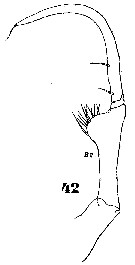 Issued from : W. Giesbrecht in Systematik und Faunistik der Pelagischen Copepoden des Golfes von Neapel und der angrenzenden Meeres-Abschnitte. - Fauna Flora Golf. Neapel, 1892. Atlas von 54 Tafeln. [Taf. 50, Fig.42 ]. Male: 42, Mxp.
|
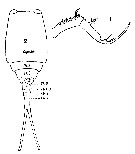 issued from : T. Mori in The Pelagic copepoda from the neighbouring waters of Japan, 1937 (1964). [Pl.78, Figs.1-2]. Female: 1, A2; 2, habitus (dorsal).
|
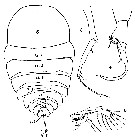 issued from : T. Mori in The Pelagic copepoda from the neighbouring waters of Japan, 1937 (1964). [Pl.78, Figs.3-6]. Male: 3, A2; 4, Mxp; 5, habitus (dorsal); 6, P4.
|
 issued from : C. Lehnhofer in Wiss. Ergebn. dt. Tiefsee-Exped. ''Valdivia'', 1926, 23 (1). [p.136, Textfig.13]. Female: 1, habitus (dorsal); 2, urosome (dorsal); 3, A2; 4, A2 (detail of segment 3); 5, P4.
|
 issued from : C. Lehnhofer in Wiss. Ergebn. dt. Tiefsee-Exped. ''Valdivia'', 1926, 23 (1). [p.126, Textfig.4, 1-4]. As Copilia mirabilis f. typica. Male: 1, A2; 2, A2 (detail segment 3); 3, distal portion of segment 4 of A2; 4, Mxp.
|
 issued from : C. Lehnhofer in Wiss. Ergebn. dt. Tiefsee-Exped. ''Valdivia'', 1926, 23 (1). [p.126, Textfig.4, 5-7]. As Copilia mirabilis f. platonyx. Male: 5, A2; 6, A2 (detail distal portion of segment 3); 7, Mxp.
|
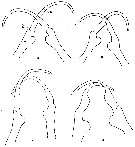 issued from : C. Lehnhofer in Wiss. Ergebn. dt. Tiefsee-Exped. ''Valdivia'', 1926, 23 (1). [p.143, Textfig.18]. As Copilia mirabilis f. typica. Male: Mxp. a, forma typica; b-c, intermediate forms; d, forma platonyx.
|
 Issued from : D. Gur, B. Leshem, V. Farstey, D. Oron, L. Addadi & S. Weiner in Adv. Funct. Mater., 2016, 26. [p.1394, Fig.1, C, D). Optical response of sapphirinid male of Copilia mirabilis to either dark or light conditions. C: dark-adapted (reflection mode); D: light-adapted (transmission mode).
|
 Issued from : D. Gur, B. Leshem, V. Farstey, D. Oron, L. Addadi & S. Weiner in Adv. Funct. Mater., 2016, 26. [p.1396, Fig.3, C, D). The reflectance and structural properties that accompany the male sapphirinid color change. C: dark-adapted; D, light-adapted. Column I: light microscope images of the specimens; column II: measured reflectance; column III: simulated reflectance spectrum. The simulated reflectance was calculed based on the cytoplasm (Cy) and the crystal (Cr) thickness measured in cryo-SEM images: Dark-adaptated Cy: 58 ± 8 nm, Cr: 63 ± 6 nm. Light-adaptated Cy: 31 ± 9 nm, Cr: 60 nm ± 8 nm. The dashed line in DIII (simulated) marks the UV regime, into which the reflection of the light-adapted shifts. Column IV: representative cryo-SEM images of the crystal-cytoplasm layer arrays.
| | | | | Ref. compl.: | | | Carl, 1907 (p.18); Wilson, 1942 a (p.179); Oliveira, 1945 (p.191); Sewell, 1948 (p.346); M.W. Johnson, 1949 (p.238); C.B. Wilson 1950 (p.191); King & Hida, 1955 (p.11); Yamazi, 1958 (p.154, Rem.); Deevey, 1960 (p.5, Table II, annual abundance) ; Ganapati & Shanthakumari, 1962 (p.10, 16); Ahlstrom & Thrailkill, 1963 (p.57, Table 5, abundance); Björnberg, 1963 (p.89, Rem.); De Decker, 1964 (p.15, 21, 27); De Decker & Mombeck, 1964 (p.12); Furuhashi, 1966 a (p.295, vertical distribution in Kuroshio region, Table 9); Neto & Paiva, 1966 (p.34, Table III); Mazza, 1966 (p.74); Séguin, 1968 (p.488); Delalo, 1968 (p.139); Deevey, 1971 (p.224); Bainbridge, 1972 (p.61, Appendix Table I: vertical distribution vs day/night, Table II: %); Binet & al., 1972 (p.73); Salah, 1971 (p.320); Björnberg, 1973 (p.370, 389); Palet, 1975 (p.660); Deevey & Brooks, 1977 (p.156, tab.2, Station "S"); Boxshall, 1977 b (p.557); Tranter, 1977 (p.596, 599); Dessier, 1979 (p.208); Chen Q-c, 1980 (p.795); Vives, 1982 (p.296); Kovalev & Shmeleva, 1982 (p.86); Dessier, 1983 (p.89, Tableau 1, Rem., %); Guangshan & Honglin, 1984 (p.118, tab.); Longhurst, 1985 (tab.2); Brinton & al., 1986 (p.228, Table 1); Renon, 1987 (tab.2); Jimenez-Perez & Lara-Lara, 1988; Lozano Soldevilla & al., 1988 (p.61); Dessier, 1988 (tabl.1); Hernandez- Trujillo, 1989 a (tab.1); Cervantes-Duarte & Hernandez-Trujillo, 1989 (tab.3); Böttger-Schnack & al., 1989 (p.1089); Othman & al., 1990 (p.561, 564, Table 1); Hirakawa & al., 1990 (tab.3); Baessa De Aguiar, 1991 (1993) (p.107); Lozano, 1991 (p.174); Hernandez-Trujillo, 1991 (1993) (tab.I); Yoo, 1991 (tab.1); Kim & al., 1993 (p.270); Seguin & al., 1993 (p.23); Webber & Roff, 1995 (tab.1); Shih & Young, 1995 (p.77); Böttger-Schnack, 1995 (p.93); 1996 (p.1087); Kotani & al., 1996 (tab.2); Chae & al., 1996 (p.20); Webber & al., 1996 (tab.1); Böttger-Schnack, 1997 (p.409); Sharaf & Al-Ghais, 1997 (tab.1); Suarez-Morales & Gasca, 1997 (p.1525); Gilabert & Moreno, 1998 (tab.1,2); Alvarez-Cadena & al., 1998 (t.1,2,3,4); Suarez-Morales, 1998 (p.345, Table 1); Suarez-Morales & Gasca, 1998 a (p.112); Noda & al., 1998 (p.55, Table 3, occurrence); Lavaniegos & Gonzalez-Navarro, 1999 (p.239, Appx.1); El-Serehy, 1999 (p.172, Table 1, occurrence); Neumann-Leitao & al., 1999 (p.153, tab.2); Dolganova & al., 1999 (p.13, tab.1); El-Sherif & Aboul Ezz, 2000 (p.61, Table 3: occurrence); Fernandez-Alamo & al., 2000 (p.1139, Appendix); Suarez-Morales & al., 2000 (p.751, tab.1); Lopez-Salgado & al., 2000 (tab.1); Lo & al., 2001 (1139, tab.I); Hsieh & al., 2004 (p.398, tab.1); Rezai & al., 2004 (p.490, tab.2); Lan & al., 2004 (p.332, tab.1); Lo & al.*, 2004 (p.218, fig.6); Gallienne & al., 2004 (p.5, tab.3); Lo & al., 2004 (p.89, tab.1); Kazmi, 2004 (p.231, Rem.: p.232); Smith & Madhupratap, 2005 (p.214, tab.6); Obuid Allah & al., 2005 (p.123, occurrence % vs metal contamination); Hwang & al., 2006 (p.943, tabl. I); Rakhesh & al., 2006 (p.93, Table 2, spatial distribution); Dias & Araujo, 2006 (p.90, Rem., chart); Lavaniegos & Jiménez-Pérez, 2006 (p.139, tab.2, Rem.); Hwang & al., 2007 (p.25); Rakhesh & al., 2008 (p.154, Table 5: abundance vs stations); Jitlang & al., 2008 (p.65, Table 1); Lan Y.-C. & al., 2008 (p.61, Table 2: indicator species); Tseng L.-C. & al., 2008 (p.153, Table 2, occurrence vs geographic distribution); Neumann-Leitao & al., 2008 (p.799: Tab.II, fig.6); Ayon & al., 2008 (p.238, Table 4: Peruvian samples); C.-Y. Lee & al., 2009 (p.151, Tab.2); Miyashita & al., 2009 (p.815, Tabl.II); C.E. Morales & al., 2010 (p.158, Table 1); Williamson & McGowan, 2010 (p.273, Table 3, Pacific central gyres: N and S); Dias & al., 2010 (p.230, Table 1); Medellin-Mora & Navas S., 2010 (p.265, Tab. 2); W.-B. Chang & al., 2010 (p.735, Table 2, abundance); Hsiao S.H. & al., 2011 (p.475, Appendix I); Tseng L.-C. & al., 2011 (p.47, Table 2, occurrences vs mesh sizes); Maiphae & Sa-ardrit, 2011 (p.641, Table 2, 3, Rem.); Tutasi & al., 2011 (p.791, Table 2, abundance distribution vs La Niña event); Johan & al., 2012 (2013) (p.1, Table 1); Uysal & Shmeleva, 2012 (p.909, Table I); Tseng & al., 2012 (p.621, Table 3: abundance); Lavaniegos & al., 2012 (p. 11, Appendix); Palomares-Garcia & al., 2013 (p.1009, Table I, abundance vs environmental factors); in CalCOFI regional list (MDO, Nov. 2013; M. Ohman, pers. comm.); Tseng & al., 2013 (p.507, seasonal abundance); Jagadeesan & al., 2013 (p.27, Table 3, seasonal abundance); Rakhesh & al., 2013 (p.7, Table 1, abundance vs stations); Hwang & al., 2014 (p.43, Appendix A: seasonal abundance) ; Bonecker & a., 2014 (p.445, Table II: frequency, horizontal & vertical distributions); Dias & al., 2015 (p.483, Table 2, abundance); Nakajima & al., 2015 (p.19, Table 3: abundance); Marques-Rojas & Zoppi de Roa, 2017 (p.495, Table 1); Abo-Taleb & Gharib, 2018 (p.139, Table 5, p.146, occurrence %); Palomares-Garcia & al., 2018 (p.178, fig.3: relative frequency, Table 1: occurrence). | | | | NZ: | 18 | | |
|
Carte de distribution de Copilia mirabilis par zones géographiques
|
| | | | | | | | | | | |  issued from : C. Lehnhofer in Wiss. Ergebn. dt. Tiefsee-Exped. ''Valdivia'', 1926, 23 (1). [p.159, Textfig.24]. issued from : C. Lehnhofer in Wiss. Ergebn. dt. Tiefsee-Exped. ''Valdivia'', 1926, 23 (1). [p.159, Textfig.24].
Zoogeographical distribution of C. mirabilis. |
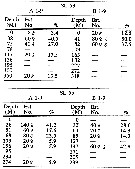 issued from : H.B. Owre & M. Foyo in Fauna Caribaea, 1, Crustacea, 1: Copepoda. Copepods of the Florida Current. 1967. [p.118, Table 58]. issued from : H.B. Owre & M. Foyo in Fauna Caribaea, 1, Crustacea, 1: Copepoda. Copepods of the Florida Current. 1967. [p.118, Table 58].
Vertical distribution of Copilia mirabilis at the ''40-Mile Station'' in the Florida Current ( E Miami: ± 25°35'N, 79°27'W; depth 738 m).
SL 55: 21 VII 1958. A: during midday; B: during midnight. |
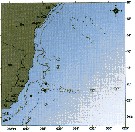 issued from : C. de O. Dias & A.V. Araujo in Atlas Zoopl. reg. central da Zona Econ. exclus. brasileira, S.L. Costa Bonecker (Edit), 2006, Série Livros 21. [p.90]. issued from : C. de O. Dias & A.V. Araujo in Atlas Zoopl. reg. central da Zona Econ. exclus. brasileira, S.L. Costa Bonecker (Edit), 2006, Série Livros 21. [p.90].
Chart of occurrence in Brazilian waters (sampling between 22°-23° S).
Nota: sampling 3 specimens. |
| | | | Loc: | | | South Africa (SE), Namibia, Angola, Congo, off S St. Helena Is., off S Ascension Is., G. of Guinea, Ivorian shelf, off E St. Paul Is., Cape Verde Is., off Mauritania, Canary Is., Argentina, Brazil (S, Campos Basin, off Vitoria-Cabo de Sao Tomé, off Macaé , off Natal), Barbada Is., Caribbean Sea, Jamaica, Caribbean Colombia, Bahia de Mochima (Venezuela), Yucatan (Ascension Bay), G. of Mexico, Cuba, Florida, Sargasso Sea, off Bermuda (Station "S"), Delaware Bay (outside), Woods Hole, Medit. (Alboran Sea, Marseille, NW Tunisia, Malta, Lebanon Basin, Egypt), G. of Suez, Sharm El-Sheikh, Taba, G. of Aqaba, Hurghada, Safâga, Red Sea, G. of Aden, Arabian Sea, Arabian Gulf (UAE coast, Kuwait), Sri Lanka, Madagascar (Nosy Bé), Rodrigues Is. - Seychelles, Mascarene Basin, Indian, India (G. of Mannar, Saurashtra coast, Lawson's Bay, Kakinada Bay, Godavari region), Bay of Bengal, Straits of Malacca, G. of Thailand, Indonesia-Malaysia, Ambon Bay, Tioman Is., Bintulu coast, Philippines, Viet-Nam, Hong Kong, China Seas (Yellow Sea, East China Sea, South China Sea), Taiwan (E, S, SW, W, NW, N, NE, Mienhua Canyon), S Korea, Japan Sea, Japan, Kuchinoerabu Is., Tanabe Bay, Pacif. ( W equatorial), Pacific (central gyres: N and S), Australia (G. of Carpentaria, Great Barrier, New South Wales), New Caledonia, Pacif. (tropical), Bikini Is., Hawaii, Pacif. (equatorial central), W Baja California, Gulf of California, Bahia of los Angeles, La Paz, W Mexico, G. of Tehuantepec, Clipperton Is., off Guatemala W, Galapagos-Ecuador, Peru, Chile (N, Concepcion) | | | | N: | 199 | | | | Lg.: | | | (45) F: 3,5-3,25; M: 5,5-5,25; (46) F: 3,5-3,25; M: 5,5-5,2; (104) F: 3,7; M: 5; (109) F: 2,5-2,3; M: 4,7-4,5; ? (135) F: 3,6; (237) F: 5,8; M: 6; (310) F: 3,76; M: 6,61-5,25; (332) F: 3,38-3,12; M: 4,47-4,23; (336) F: 3,73; (458) M: 4,95; 4,87; (530) F: 2,2; M: 3,2; (531) F: 3,2; M: 4,5; (618) F: 2,88-2,83; (651) F: 4,03-2,69; M: 5,92-5,28; (703) F: 4,1-2,2; M: 6,1-3,2; (785) F: 2,43-2,13; M: 5,12-4,56; (788) F: 3,05-2,35; M: 4,13-3,6; (794) M: 5,7-5,2; (866) F: 3,8-2,72; M: 5,4-4,41; (937) F: 3,27-3,29; (991) F: 2,20-4,10; M: 3,20-6,10; {F: 2,13-5,80; M: 3,20-6,61} | | | | Rem.: | épi-mésopélagique.
.
Copilia mirabilis platonyx Lehnhofer,1926 (M)
Ref.: Lehnhofer, 1926 (p.127, 143, figs.M); Farran, 1936 a (p.132); Dakin & Colefax, 1940 (p.109, fig.M); Sewell, 1947 (p.271, Rem.: zoogéographie); Paiva, 1971 (p.40, Rem.); Chihara & Murano, 1997 (p.990, figs.M); Conway & al., 2003 (figs.M, Rem.); Shimode & Shirayama, 2004 (tab.2)
Loc.: Mer Arabe, Is. Maldives, Japon, Australie (Grande Barrière, Nouvelle-Galles du Sud)
N: 4
Lg.: (310) M: 6,41-5,4
.
Copilia mirabilis typica Lehnhofer,1926 (F,M)
Ref.: Lehnhofer, 1926 (p.125, 135, 143, figs.F,M); Sewell, 1947 (p.270); Paiva, 1971 (p.40, Rem.); Chihara & Murano, 1997 (p.992, figs.M)
Loc.: Atlant. équatorial, Afr. E, G. d'Oman, Mer Arabe, Is. Maldives, Indonésie-Malaisie, Japon, Australie (Grande Barrière)
Voir aussi les remarques en anglais | | | Dernière mise à jour : 13/11/2020 | |
|
|
 Toute utilisation de ce site pour une publication sera mentionnée avec la référence suivante : Toute utilisation de ce site pour une publication sera mentionnée avec la référence suivante :
Razouls C., Desreumaux N., Kouwenberg J. et de Bovée F., 2005-2025. - Biodiversité des Copépodes planctoniques marins (morphologie, répartition géographique et données biologiques). Sorbonne Université, CNRS. Disponible sur http://copepodes.obs-banyuls.fr [Accédé le 30 décembre 2025] © copyright 2005-2025 Sorbonne Université, CNRS
|
|
 |
 |






















